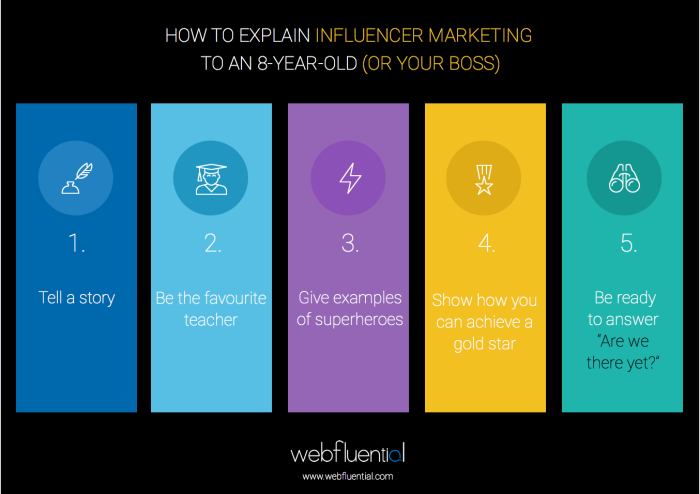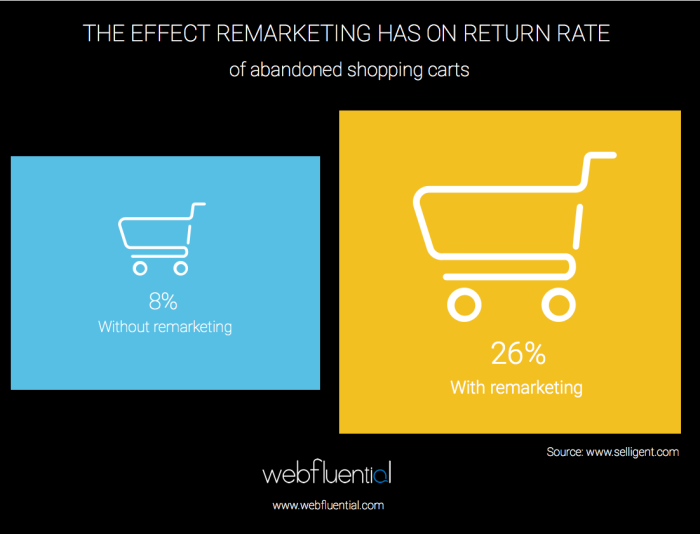Categories for Marketing
October 13, 2015 4:12 pm
Published by Kirsty Sharman
Editors note: This article originally appeared on tech.co to help answer a question we get from marketers often on how to pitch Influencer Marketing and get buy-in from the top.

You have read all the recent Influencer Marketing case studies and are a little jealous of the return other brands are achieving. You would prefer to be the ‘cool kid’ rather than the ‘new kid’ on the block and have a great idea for an Influencer Marketing campaign. There is one thing stopping you from achieving rock star status with your branded content – approval from your boss.
You recognise Influencer Marketing is a necessary addition to your marketing budget, but how do you get buy-in from the top? It is simpler than you think. Just explain the concept of Influencer Marketing to your boss, as you would to an 8-year-old child.

1. Tell a story
As humans, we are wired to be captivated by stories and easily recall information if it is relayed to us with rich meaning and visual cues. Stories engage the emotional side of our brains and drive us to take action. If you open your pitch with a story, you will be able to grab attention, make facts stick and data more retainable and understandable.
You know your boss best and what story would be relevant to them. Perhaps share a personal story of why you booked the company lunch at a restaurant that a friend recommended on Facebook. You could relate your story back to relevant stats such as: the average consumer mentions specific brands over 90 times a week in conversation with friends or family or that 68% of people feel that Facebook is the most trusted platform for product and service recommendations.
Tip: Don’t make your story long, but make it memorable.
2. Be the favourite teacher
We all had a favourite teacher at school that was an expert at explaining complex topics. Influencer Marketing is new and can appear to be overwhelming if explained poorly or if not understood correctly. It is important to provide background information, definitions, statistics etc. but don’t overcomplicate things to appear smart or knowledgeable on the topic.
Instead, keep things simple and avoid using too many technical terms that although might be relevant, make your boss feel that you need to be a rocket scientist to run a successful Influencer Marketing campaign. Don’t make them feel you are under qualified to do the job. Instead, make them feel confident that you have done enough research to take advantage of this new opportunity and are convinced of the value Influencer Marketing can add to your business and marketing plans.
Tip: When explaining complex topics, show how something works rather than resorting to just talking about a topic.
3. Gives examples of superheroes
My own childhood superheroes were the Ninja Turtles and I was absolutely convinced that nothing could ever beat their ninja moves. In the world of marketing, there are many brand superheroes that kick butt at Influencer Marketing. The internet is full of case studies and examples that you can use to showcase potential success and return on investment. Search for case studies related to your industry, business objectives or even concepts you find innovative. These case studies will provide credibility to your pitch and also give you a foundation for best practice.
Tip: Show what your competitors are doing with their own Influencer Marketing plans and explain how you will differentiate your business. If they are not using Influencer Marketing yet, this is an added opportunity to highlight.
4. Show how you can achieve a gold star
Now that you have given the background into what Influencer Marketing is and have shown the results that other brands are achieving, you need to explain why you think it is relevant for your business and how you plan on achieving your own Influencer Marketing gold star status. This is the point you need to reveal how it will add value to your business.
The most effective way to do this is to show that you have already put thought into your own Influencer Marketing plan. As an Influencer Marketing platform, we have experience in planning campaigns and have developed a 6-step model to make building a successful plan easier. In short, a solid Influencer Marketing plan will specify the target market, propose a campaign that meets the business objectives, identify relevant influencers, explain how workflow and logistics will be managed, as well as how you will track the results.
Tip: Having a plan instils more confidence that the additional investment has potential to add value. Ensure that you showcase what you foresee as being the potential return on investment for the new budget allocation. Use your Influencer Marketing plan to propose not only how you will achieve your first gold star, but also how it is sustainable to be awarded ongoing gold stars.
5. Be ready to answer “Are we there yet?”
Once you have buy-in and approval to go ahead, first give yourself a pat on the back and then be prepared to answer many eager progress questions. Trying something new and innovative is not just exciting for you, but all the stakeholders involved. You will be anxious to prove your campaign victorious and your boss will want regular updates on the status and results.
Tip: There are Influencer Marketing platforms and tools which make tracking your campaign results easy. This is important to not only showcase success, but also to justify ongoing Influencer Marketing budget. Investment in tools like, Webfluential, help you answer the question, “Are we there yet”, with confidence and provide all of the relevant data of the journey.
The tips I have shared are intended to help you put your best foot forward when explaining Influencer Marketing to your boss. Just remember that you know the audience you need to pitch to best – so tweak and personalise your content to what is most relevant to them.

Share this article
September 16, 2015 9:59 am
Published by Kirsty Sharman
Have you ever browsed the web and felt that whatever website you visit; you see ads from the online store you visited the day before? Whether you are catching up on news on CNN or browsing Facebook pics of a friend’s holiday, ads keep popping up (like magic) with the shoes you decided were not essential. However, this is not the act of your Fairy Godmother waving her wand to ensure you have this seasons latest kicks, but it is rather part of a strategic remarketing campaign.
One of the most crucial questions for any business is “How do I attract more customers?” The corner store wants to increase foot traffic, a steakhouse wants more reservations and the online shoe shop wants to have less abandoned shopping carts. However, in the over-competitive online world, discovering a website may be easy, but leaving it is as simple as clicking a button. The more important business question in this case is “How do I get them to come back?”
Remarketing is used to reach past website visitors or app users. It is a smart way to reach out to people who may not have made an immediate purchase or taken up your call to action on first visit. It gives you the opportunity to reconnect with potential customers by positioning targeted ads in front them when they are browsing elsewhere on the web.
Put simply, one uses marketing to bring a visitor to your website, and when they do not make a purchase, you then use remarketing tactics to bring them back to your website and convert them into paying customers. Remarketing is a great tool to add to your Influencer Marketing campaign. Lets find out why.
Using dynamic remarketing to customise ads
Dynamic remarketing takes things a step further by including products or services that people viewed on your website within the ads. This delivers a customised and more relevant ad to the potential customer. They are more likely to take note of the ad as they recognise the product displayed from their previous browsing or abandoned shopping carts. This connection makes them more likely to buy. Linking back to the shoe example, this would be viewing ads for the green Nike trainers you left abandoned in your shopping cart, whilst browsing other websites.
How does remarketing work?
Remarketing ads can be delivered to a defined audience in both text and image display formats. The ads are managed by Google AdWords and are displayed on web pages visited by your target audience that accept Google advertising placements.
The technology behind remarketing works by placing *cookies that are stored on the visitor’s computer when browsing. Their cookie ID is added to your remarketing list to serve relevant and customised ads.
How successful is remarketing?
The central principle of remarketing is to retain the attention of people that have already expressed an interest in your business. Therefore, for remarketing to be successful you need to ensure that your ad is highly relevant to what your visitors are looking for and that there is some enticement for them to return to your website. For example, perhaps I decide to buy the green Nike trainers as the remarketing ads show me a 10% discount code or offer me a gift certificate on my first purchase.
When used correctly, remarketing is a powerful tool for repeat website traffic, sales conversions or creating brand awareness. This is why remarketing is sometimes referred to as ‘conversion marketing’ and is a great tool for driving return on investment (ROI).
A Google case study, of Loews Hotel Group, showcases how they shifted 70 percent of their offline ad spend to online last year. The hotel group started using remarketing and the overall results were very favourable. Revenue increased 10 percent, bookings went up 9 percent and unique site visitors increased by 5 percent. However, the most impressive number was the $60,000 in sales that the $800 remarketing campaign produced.
Remarketing is believed to be the ultimate tool to address the problem of abandoned shopping carts and increase sales conversions. A study showcased on Selligent found that the return rate of customers that abandon shopping carts without remarketing is 8 percent, but with remarketing the return rate increases to 26 percent.

In an era where our time is continually diverted to something new and we are bombarded with messaging, it is important to remain relevant and at the forefront of a potential customer’s mind. Remarketing allows marketers to strategically target people that have already expressed interest in their business and remind them to purchase the green Nike sneakers they abandoned in their shopping cart. With a little added enticement from a remarketing campaign, 26 percent of those customers will return to purchase the shoes.
*A cookie is a small bit of code that helps a web browser store data about websites.
Share this article
August 19, 2015 1:51 pm
Published by Murray Legg
Whether you’re a blogger or a brand, you’ve grown and refined your tone and approach to creating and sharing content with your audience over a period of time. The topics you discuss, the articles you share and the amount you engage with people is not only an expression of yourself or your brand, but rewarding on a social, personal and economic front.
We recently wrote about the six steps to building a successful influencer marketing plan, outlining best practice to engage with influencers and achieve meaningful results with your influencer marketing campaigns. But what about the best approach to captivating your audience through the content you create and go on to maximize the shareability of your it?
In 2006, while still at the Huffington Post, Jonah Peretti started BuzzFeed with a small amount of seed funding. It’s gone on to become an internet content hub of huge significance. Peretti has experience in creating content that gets huge traction online. Remember 40 Things That Will Make You Feel Old (3.2 million views), and the 45 Most Powerful Images of 2011 (10.1 million)?
We looked into the online forums and business analyses of the BuzzFeed model and have created a list of tips to putting together great branded content.

Emotionally engaging content does best
The reason kittens and memes tend to be shared so much is their innate emotional connection. By exploring the emotional connection of your content with your audience, you’ll have a good shot at it getting traction. Think about a fitness brand doing a piece on the 15 best workout songs, for example.
Target the “Bored at Work Network”
“Bigger than the BBC, CNN or any traditional media network is the “BWN” and is made up of millions of bored office workers blog, Tweet, Facebook and IM all day.” In the new world of networked media, where links passed via social networks can send millions of pageviews to a site in a matter of minutes, Peretti says the bored-at-work network effectively “decides what content is popular today.”
Employ the mullet strategy
Business in the front, party in the back. YouTube, CNN, BuzzFeed and Huffington Post all have an incredible slick front page that’s visual and able to draw people into their content. Behind the front page, users can argue, comment and fight things out in the comments section. Remember, you wrote emotional content to start with, so give your audience an easy way to discuss it.
If your readers are on your website, make it shareable
Every BuzzFeed article has several icons at the top and bottom of its articles, for sharing on StumbleUpon, Google Plus, and Twitter, among others. Users can also pass judgment on a story using BuzzFeed’s proprietary yellow reaction button system, which include “LOL,” “omg,” “wtf,” “fail,” and “ew.”
Seed the content in fertile land
“Big seed marketing” hinges on the basis that content going viral needs to be different to how a disease goes viral. A virus epidemic starts with a single patient, “patient zero” and has a break out from there. But what if there were many patient zeros, based in different networks, giving your content an opportunity to go on to a wider audience?
Assume people aren’t reading your content on your website
“What if you assume people’s home page isn’t your site but Facebook or Twitter or StumbleUpon, or one of these social sites?” Repurpose your content and share it on your social channels to reach a wider audience.
Sign up as a marketer if you would like to find out more or start using our platform to run successful Influencer Marketing campaigns.
References:
http://www.businessweek.com/printer/articles/14770-buzzfeed-the-ad-model-for-the-facebook-era
http://www.techtimes.com/articles/38013/20150306/buzzfeed-make-money.htm
https://hbr.org/2007/05/viral-marketing-for-the-real-world
Share this article






